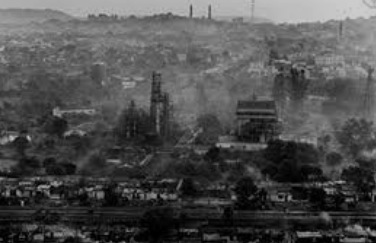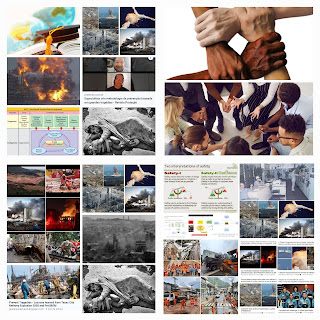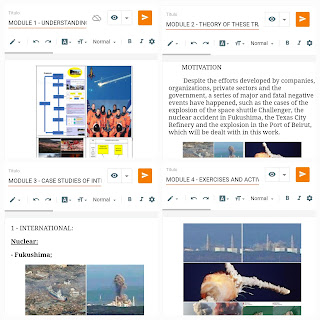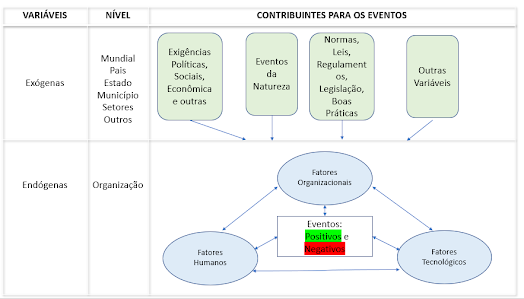MODULE 3 - CASE STUDIES OF INTERNATIONAL MAJOR NEGATIVE AND FATAL EVENTS
CASE STUDIES OF INTERNATIONAL MAJOR NEGATIVE AND FATAL EVENTS
In this module, reduced versions of major negative events, fatalities, and other types of events are presented.
There are links with information about these events, which require authorization to access, others, I left open.
If you are interested in accessing links in this module, which require authorization, send an email to:
washington. fiocruz@gmail.com
Some of the Case Studies of Big Negative Events that you will find in this module.
International:
Seveso, Fukushima, Challenger, Columbia, Texas City Refinery, Port of Beirut Explosion, Bophal, Air France 447, Piper Alpha, Deep Water Horizon Platform, Boeing 737 Max.
There are also in this module, highlights with indication of books, articles and other publications.
1 - INTERNATIONAL:
Nuclear:
- Fukushima;
Figure - Devastation by the Tsunami in Fukushima and the Explosion at the Nuclear Power Plant in Fukushima
The authorities responsible for the plant knew of the possibility of larger waves than those designed to contain the flooding of the plant by tsunami waves. A historical study revealed that a major tsunami occurred in the middle of the 9th century, estimated at 869 AD, and that a researcher had made a strong recommendation for refurbishment of the plan in 2006, but the recommendation was supposedly turned down for the reason, that the tsunami was hypothetical, and because the claimed evidence was not accepted by experts in the nuclear sector.
Lessons learned from the Fukushima accident:
The IAEA 2015 report's recommendations included a few that specifically address the issue of overconfidence:
“The assessment of natural hazards needs to be sufficiently conservative. The consideration of mainly historical data in establishing the design basis of nuclear power plants is not enough to characterize the risks of extreme natural hazards. Even when comprehensive data are available, due to relatively short observation periods, large uncertainties remain in predicting natural disasters.
The safety of nuclear power plants needs to be periodically reassessed to take account of advances in knowledge, and the necessary corrective actions or compensatory measures need to be implemented promptly.
Onagawa: The Japanese nuclear power plant that didn’t melt down on 3/11:
More information at:
This assessment does not cover organizational factors and exogenous variables (see Module 2 of the Proactive Safety Risks and Emergencies course), it would be good to expand this analysis.
For more information send an email to washington.fiocruz@gmail.com
-------
Video:
A journalistic look at the TMI accident:
More information at:
- Chernobyl;
Chernobyl - Violation of Safety Regulations and Chernobyl Disaster: What Happened and Long-Term Impacts
The accident at a nuclear power plant in the Soviet Union shocked the world, permanently altered the region and left many questions unanswered.
BY ERIN BLAKEMORE
On April 25 and 26, 1986, the reactor of a nuclear power plant exploded and caught fire in what is now northern Ukraine, triggering the worst nuclear accident in history. Shrouded in mystery, the disaster was a watershed moment in both the Cold War and the history of nuclear power. More than 30 years later, scientists estimate that the area around the ancient plant will remain uninhabitable for up to 20,000 years.
The disaster occurred near the city of Chernobyl, in the former Soviet Union, which invested heavily in nuclear power after World War II. Beginning in 1977, Soviet scientists installed four RBMK nuclear reactors (high-power piped reactors) at the power plant, located just south of the present-day border between Ukraine and Belarus.
On April 25, 1986, routine maintenance was scheduled to take place on the fourth reactor at the V.I. Lenin. Engineers planned to use the occasion to test whether the reactor could still be cooled if the power plant lost power. During the test, however, operators breached safety protocols and the reactor was overloaded. Despite attempts to completely shut down the reactor, another overload triggered a chain reaction of explosions inside. Eventually, the reactor core was exposed, releasing radioactive material into the atmosphere.
This assessment does not cover organizational factors and exogenous variables (see Module 2 of the Proactive Safety Risks and Emergencies course), it would be good to expand this analysis.
For more information send an email to washington.fiocruz@gmail.com
-------
Video:
Other references:
More information at:
https://drive.google.com/drive/u/2/folders/1hLRs8ke1rbKv6DEkvEZNA9nH9tn2X7_6
Aerospace:
- Challenger;
Figure - Explosion of the Space Shuttle Challenger
https://drive.google.com/drive/u/2/folders/1yJIWv-sfj1nGLKVWw63AuDFFDb6Tjlu7
- Columbia;
Figure - Explosion of the Space Shuttle Columbia and its Crew
https://drive.google.com/drive/u/2/folders/1L4D9-lAxqkNTcnAQNVt0halSlBIxXk6l
Petrochemical:
- Texas City Refinery;
Figure - Accident at the Texas City Refinery
On March 23, 2005, a catastrophe in American industrial history took place at the BP refinery in Texas City, Texas. Explosions of hydrocarbon vapors, followed by fires, left 15 dead and 180 injured.
The Texas City Refinery was the second largest oil refinery in the state, and the third largest in the United States, with an input capacity of 437,000 barrels (69,500 m3) per day as of January 1, 2000. BP acquired the Texas City Refinery as part of its merger with Amoco in 1999.
Financial losses amounted to 1.5 billion dollars, 43,000 people could not leave their homes. Buildings were damaged in a perimeter of around 1,200m around the refinery.
For more information send an email to washington.fiocruz@gmail.com
-----------
Article:
James Reason, pathogens, organizational, technical factors in the Texas City Refinery accident:
More information at:
- Piper Alpha;
- Deep Water Horizon Platform:
Figures - Deep Water Horizon Platform Explosion
For governments:
• Governments should establish well-resourced security case regimes.
For regulatory bodies:
• Regulators need to carefully scrutinize and challenge company risk assessments.
• Regulators should ask companies to demonstrate that their compensation systems effectively address the risk of serious harm. In particular, they should require companies to demonstrate that key executive performance agreements are properly focused on serious risks. (There is a good argument that top executive performance agreements should be made public, subject to editing to remove truly confidential information.)
• Regulators should challenge companies to demonstrate that their organizational structures are adequate for managing serious risks.
Andrew Hopkins
More information at:
Book:
Hopkins presentation about this accident:
https://drive.google.com/drive/u/2/folders/1IiciVTYf0VjuaZEGru2TyBOiRndx2fXi
Video of the Decision-Making Process:
https://drive.google.com/drive/u/2/folders/1kBOqQr-qmsHV-bIxR05ytobhEj5aVFqQ
Disaster:
- Explosion of the Port of Beirut:
Figure - Explosion of the Port of Beirut
From 2014 to 2020, documents were presented to the authorities of the Port of Beirut, the Prime Minister and the President of Lebanon, as will be presented in this article, evidence of the organizational factor of government structures as a precursor to this great tragedy in which more than 200 people died and 6 thousand were injured in an explosion in the port of Beirut, Lebanon, which completed a year on 04/08/2021.
The explosion was caused by ammonium nitrate that had been unsafely stored in the port for years.
No government official was ever penalized for the explosion. The investigation stalled after there were requests to gather data on politicians.
For more information send an email to washington.fiocruz@gmail.com
Articles:
More information at:
https://drive.google.com/drive/u/2/folders/1n6jy-qTS5RCmDT24Q1UHf1t3jYWiF3f3
Aviation:
- Air France 447:
Figure - AF-447 Airplane Parts Rescue Operation
Incidents very similar to that of the Air France Airbus A330-200 occurred the year before the accident, with two identical planes from a Caribbean airline, Air Caraïbes. They were caused by the formation of ice in the Pitot tubes when passing through zones of storm and turbulence. These tubes have been pointed out in recent days as possibly being responsible for the crash of flight AF447 into the Atlantic Ocean, on the last day of the 31st. Airbus headquarters in France from the problem. An internal report by Air Caraïbes states that Airbus was studying, in December last year, changing the Pitot tubes of all similar planes manufactured by the company.
For more information send an email to washington.fiocruz@gmail.com
-----------
Articles:
Video:
More information at:
- Boeing 737 Max:
Chemical:
- Seveso;
Figure - Children with Accidents, Dead Animals, the Factory, Emergency Operation
The accident
On July 10, 1976, in Seveso, a province of Milan, Italy, a leak of dioxin caused the contamination of 320 hectares, affecting thousands of people and animals. It was one of the biggest ecological disasters in the world.
Around 12:30 pm on the day of the accident, a reactor safety disk ruptured, resulting in the emission of a large toxic cloud into the atmosphere.
The reactor was part of the TCP (trichlorophenol) manufacturing process and the toxic cloud formed contained several components including TCP itself, ethylene glycol and
2,3,7,8-tetrachlorodibenzoparadioxin (TCDD). The cloud spread over a large area, contaminating people, animals and the soil in the vicinity of the industrial unit.
The plant operated on a batch basis and, at the time of the accident, was paralyzed for the weekend. However, the reactor contained material at a high temperature. Probably, the presence of ethylene glycol with sodium hydroxide caused an uncontrolled exothermic reaction, causing the internal pressure of the vessel to exceed the rupture pressure of the safety disk, causing the emission. The reaction that occurred, associated with a temperature between 400 and 500 ºC, contributed to the formation of TCDD.
For more information send an email to washington.fiocruz@gmail.com
-----------
Articles:
More information at:
https://drive.google.com/drive/u/2/folders/1i2nhYvWn7VMo92IC9LWZr18QXyz8IWwQ
- Bhopal;
Figures - Factory and Victims of the Bophal Accident
Vídeo Bophal
Largest industrial crime in history totals 600,000 victims and affects 3rd generation in India
Gas that leaked from a US pesticide factory in 1984 contaminates children and grandchildren of survivors
Praveen S.
The biggest industrial crime in history took place almost 36 years ago in Bhopal, central India, and it continues to claim victims. About 27 tons of methyl isocyanate gas leaked from a disused agrochemical factory owned by the US company Union Carbide in the early hours of December 3, 1984. At least 2,200 people died immediately after inhaling the toxic substance, and there is no prospect of prevent the contamination of future generations.
The International Campaign for Justice in Bhopal estimates that the total number of deaths as a result of the spill is over 25,000 and warns that the number of those affected is increasing day by day, approaching 600,000. The last official statistic from the Indian government is from 2006 and recognizes 558,000 victims.
A survey conducted by the Scientific Advisory Committee of the Medical Research Council of India in 2017 showed that women who inhaled the toxic gas in 1984 have a 9% chance of giving birth to babies with genetic malformations. The incidence of disorders is almost six times lower among children of mothers not exposed to methyl isocyanate.
Contaminated Lives
Since 1984, those affected have tried to call the attention of the media and the courts to the worsening impacts in Bhopal. After marching 770 km to New Delhi and holding protests every anniversary of the leak, they raised funds to maintain clinics and rehabilitation centers in the city, as well as guaranteeing investments in basic sanitation in the region.
For more information send an email to washington.fiocruz@gmail.com
-----------
Articles:
More information at:
https://drive.google.com/drive/u/2/folders/1fMMqj9q0loRDEqS6Zjx7j-EBBZN9jjQ5
- Flixborgh;
https://drive.google.com/drive/u/2/folders/1rC0MnnCHs_q19AHB8wj5T8jl1VMsD6Cm
Mining:
- Brumadinho:
Figure - Failure of the Vale dam in Brumadinho
Failure of the Córrego do Feijão mine dam in Brumadinho, lessons that should have been learned:
• The effectiveness of the drainage system must be improved until the minimum FS established in norms and regulations is obtained;
• Auscultation or monitoring instruments (such as piezometers, water level indicators and inclinometers) must be properly maintained and replaced whenever necessary;
• The Risk Chart, a document that points out the reference levels for the auscultation instruments, must be revised whenever new instruments are installed;
• Surge in surface structures, on slopes and at the foot of dams must be taken into account, as they indicate the failure of the internal drainage system;
• The width of the tailings beach must be respected as determined in the dam operation manual;
• Geotechnical investigations must be deepened so that the parameters that characterize the residues and soils of dikes and foundations are in fact known;
• The emergency communication system, to alert workers and the community downstream of the dams, must be activated immediately after finding a failure;
• Audit companies must be careful when using soil and waste resistance parameters, in view of their great variability; It is
• The top management of companies must be quick in taking decisions after the recommendations made by the audits.
Reference:
Rompimento das barragens de Fundão e da Mina do Córrego do Feijão em Minas Gerais, Brasil: decisões organizacionais não tomadas e lições não aprendidas
From Marcos Ribeiro Botelho et al.
For more information send an email to washington.fiocruz@gmail.com
-----------
Articles:
More information at:
https://drive.google.com/drive/u/2/folders/1yx0xkFHTmbbQNYuH7PpW0sMVf4EuseTn




















Comentários
Postar um comentário